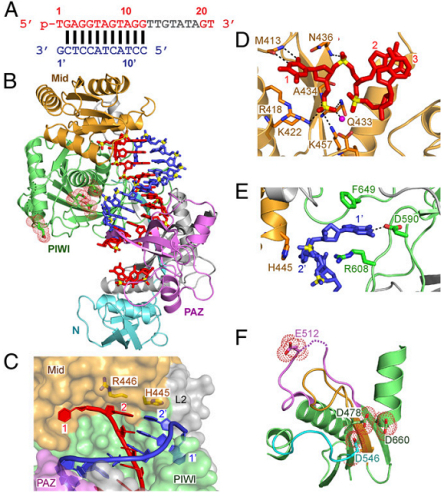Crystal structures provide new insight into DNA cleavage mechanism of Thermus thermophilus Argonaute
RNA silencing is a kind of cellular regulating system for mRNA cleavage or translation repression mediated by RNA induced silencing complex (RISC) under sequence-specific direction of small RNAs. Better understanding of RNA silencing mechanism is important for the fields of genomics, biomedicine, and experimental biology.
Argonaute proteins are the core component of RNA-induced silencing complex (RISC) essential for RNAi. Argonaute proteins selectively recruit mRNAs and sRNAs and also interact with Dicers.
In the last few decades, biology of RNA silencing of TtAgo ternary complexes with guide DNA and added target RNAs has been limited by its modest structural resolution (2.8-3.0 angstrom resolution). Further progress resolving cleavage mechanism was hampered by this low resolution. Professor WANG Yanli at the Institute of Biophysics, Chinese Academy of Sciences and her colleagues have broken the limit to TtAgo ternary complexes with guide DNA and target DNA strands by growing crystals of ternary complexes that diffract to higher (2.2–2.3 angstrom) resolution in the cleavage-incompatible, cleavage-compatible, and post cleavage steps. By identifying the relative positions of catalytic residues, a pair of Mg2+ cations, and the nucleophilic water poised for in-line attack on the cleavable phosphate, the researchers have demonstrated high-resolution structures of TtAgo ternary complexes and provided snapshots of distinct key steps in the catalytic cleavage pathway, opening opportunities for experimental probing into DNA target cleavage as a defense mechanism against plasmids and possibly other mobile elements.
This work has been recently published in the journal of PNAS (http://www.pnas.org/content/111/2/652.long), and was supported by the Ministry of Science and Technology of China, and National Natural Science Foundation.
Figure:Crystal structure and interactions in the TtAgo ternary complex with 5′-phosphorylated 21-mer guide DNA and 12-mer target DNA complementary to segment 2–12 of the guide strand in Mg2+-containing solution.


